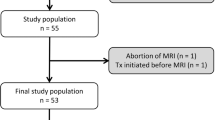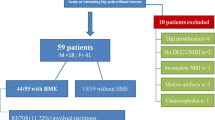Abstract
Objectives
The aim of this systematic review and meta-analysis was to assess the sensitivity and specificity of dual-energy CT (DECT) for the detection of bone marrow oedema (BME).
Methods
An electronic search of the PubMed and EMBASE databases was conducted. Bivariate modelling and hierarchical summary receiver-operating characteristic modelling were performed to evaluate the overall diagnostic performance of DECT for BME. Subgroup analysis was performed according to the assessment type (qualitative vs. quantitative) and anatomical location (spine vs. appendicular skeleton). Meta-regression analyses were performed according to the subject, study, and DECT characteristics.
Results
Twelve eligible studies (1901 lesions, 450 patients) were included. DECT exhibited a pooled sensitivity of 0.85 [95% confidence interval (CI): 0.78–0.90] and a pooled specificity of 0.97 (95% CI: 0.92–0.98) for BME detection. In addition, the diagnostic performance of qualitative assessment (sensitivity, 0.85; specificity, 0.97) was higher than that of quantitative assessment (sensitivity, 0.84; specificity, 0.88) of DECT findings. The diagnostic performance of DECT for the spine (sensitivity, 0.84; specificity, 0.98) and appendicular skeleton (sensitivity, 0.84; specificity, 0.93) were excellent. According to meta-regression analysis, the use of a tin filter, ≥ 2 image planes, and a slice thickness < 1 mm tended to exhibit higher sensitivity and hyperacute stage BME (< 24 h) tended to exhibit lower sensitivity.
Conclusions
These findings indicate that DECT has excellent sensitivity and specificity for BME detection. Qualitative assessment of DECT findings obtained using a tin filter, ≥ 2 image planes, and a 0.5-1-mm slice thickness in the acute stage BME (≥24 h) is recommended for more sensitive diagnosis.
Key Points
• Overall, DECT is useful for the detection of BME (sensitivity, 85%; specificity-97%).
• Qualitative assessment (sensitivity-85%; specificity-97%) is more accurate than quantitative assessment (sensitivity-84%; specificity-88%).
• DECT showed excellent diagnostic performance for both the spine/appendicular skeleton (sensitivity-84%/84%; specificity-98%/93%).






Similar content being viewed by others
Abbreviations
- BME:
-
Bone marrow oedema
- DECT:
-
Dual-energy computed tomography
- HSROC:
-
Hierarchical summary receiver-operating characteristic
- QUADAS-2:
-
Quality assessment of diagnostic accuracy studies-2
- VNCa :
-
Virtual non-calcium
References
Boks SS, Vroegindeweij D, Koes BW, Hunink MG, Bierma-Zeinstra SM (2006) Follow-up of occult bone lesions detected at MR imaging: systematic review. Radiology 238:853–862
Carberry GA, Pooler BD, Binkley N, Lauder TB, Bruce RJ, Pickhardt PJ (2013) Unreported vertebral body compression fractures at abdominal multidetector CT. Radiology 268:120–126
Memarsadeghi M, Breitenseher MJ, Schaefer-Prokop C et al (2006) Occult scaphoid fractures: comparison of multidetector CT and MR imaging--initial experience. Radiology 240:169–176
Geijer M, Dunker D, Collin D, Gothlin JH (2012) Bone bruise, lipohemarthrosis, and joint effusion in CT of non-displaced hip fracture. Acta Radiol 53:197–202
Mandalia V, Fogg AJ, Chari R, Murray J, Beale A, Henson JH (2005) Bone bruising of the knee. Clin Radiol 60:627–636
Pache G, Krauss B, Strohm P et al (2010) Dual-energy CT virtual noncalcium technique: detecting posttraumatic bone marrow lesions--feasibility study. Radiology 256:617–624
Diekhoff T, Hermann KG, Pumberger M, Hamm B, Putzier M, Fuchs M (2017) Dual-energy CT virtual non-calcium technique for detection of bone marrow edema in patients with vertebral fractures: a prospective feasibility study on a single- source volume CT scanner. Eur J Radiol 87:59–65
Diekhoff T, Scheel M, Hermann S, Mews J, Hamm B, Hermann KA (2017) Osteitis: a retrospective feasibility study comparing single-source dual-energy CT to MRI in selected patients with suspected acute gout. Skeletal Radiol 46:185–190
Guggenberger R, Gnannt R, Hodler J et al (2012) Diagnostic performance of dual-energy CT for the detection of traumatic bone marrow lesions in the ankle: comparison with MR imaging. Radiology 264:164–173
Kellock TT, Nicolaou S, Kim SSY et al (2017) Detection of bone marrow edema in nondisplaced hip fractures: utility of a virtual noncalcium dual-energy CT application. Radiology 284:798–805
Wang CK, Tsai JM, Chuang MT, Wang MT, Huang KY, Lin RM (2013) Bone marrow edema in vertebral compression fractures: detection with dual-energy CT. Radiology 269:525–533
Liberati A, Altman DG, Tetzlaff J et al (2009) The PRISMA statement for reporting systematic reviews and meta-analyses of studies that evaluate health care interventions: explanation and elaboration. PLoS Med 6:e1000100
Whiting PF, Rutjes AW, Westwood ME et al (2011) QUADAS-2: a revised tool for the quality assessment of diagnostic accuracy studies. Ann Intern Med 155:529–536
Kim KW, Lee J, Choi SH, Huh J, Park SH (2015) Systematic review and meta-analysis of studies evaluating diagnostic test accuracy: a practical review for clinical researchers-part I. General guidance and tips. Korean J Radiol 16:1175–1187
Lee J, Kim KW, Choi SH, Huh J, Park SH (2015) Systematic review and meta-analysis of studies evaluating diagnostic test accuracy: a practical review for clinical researchers-part II. Statistical methods of meta-analysis. Korean J Radiol 16:1188–1196
Suh CH, Park SH (2016) Successful publication of systematic review and meta-analysis of studies evaluating diagnostic test accuracy. Korean J Radiol 17:5–6
Higgins J, Green S Cochrane handbook for systematic reviews of interventions. Version 5.1.0. The Cochrane Collaboration. http://handbook.cochrane.org/chapter_9/9_5_2_identifying_and_measuring_heterogeneity.htm.
Deville WL, Buntinx F, Bouter LM et al (2002) Conducting systematic reviews of diagnostic studies: didactic guidelines. BMC Med Res Methodol 2:9
Deeks JJ, Macaskill P, Irwig L (2005) The performance of tests of publication bias and other sample size effects in systematic reviews of diagnostic test accuracy was assessed. J Clin Epidemiol 58:882–893
Ai S, Qu M, Glazebrook KN et al (2014) Use of dual-energy CT and virtual non-calcium techniques to evaluate post-traumatic bone bruises in knees in the subacute setting. Skeletal Radiol 43:1289–1295
Dareez NM, Dahlslett KH, Engesland E, Lindland ES (2017) Scaphoid fracture: bone marrow edema detected with dual-energy CT virtual non-calcium images and confirmed with MRI. Skeletal Radiol 46:1753–1756
Pache G, Bulla S, Baumann T et al (2012) Dose reduction does not affect detection of bone marrow lesions with dual-energy CT virtual noncalcium technique. Acad Radiol 19:1539–1545
Biondi M, Vanzi E, De Otto G et al (2016) Water/cortical bone decomposition: a new approach in dual energy CT imaging for bone marrow oedema detection. A feasibility study. Phys Med 32:1712–1716
Bierry G, Venkatasamy A, Kremer S, Dosch JC, Dietemann JL (2014) Dual-energy CT in vertebral compression fractures: performance of visual and quantitative analysis for bone marrow edema demonstration with comparison to MRI. Skeletal Radiol 43:485–492
Cao JX, Wang YM, Kong XQ, Yang C, Wang P (2015) Good interrater reliability of a new grading system in detecting traumatic bone marrow lesions in the knee by dual energy CT virtual non-calcium images. Eur J Radiol 84:1109–1115
Karaca L, Yuceler Z, Kantarci M et al (2016) The feasibility of dual-energy CT in differentiation of vertebral compression fractures. Br J Radiol 89:20150300
Kaup M, Wichmann JL, Scholtz JE et al (2016) Dual-energy CT-based display of bone marrow edema in osteoporotic vertebral compression fractures: impact on diagnostic accuracy of radiologists with varying levels of experience in correlation to MR imaging. Radiology 280:510–519
Na D, Hong SJ, Yoon MA et al (2016) Spinal bone bruise: can computed tomography (CT) enable accurate diagnosis? Acad Radiol 23:1376–1383
Petritsch B, Kosmala A, Weng AM et al (2017) Vertebral compression fractures: third-generation dual-energy CT for detection of bone marrow edema at visual and quantitative analyses. Radiology 284:161–168
Reddy T, McLaughlin PD, Mallinson PI et al (2015) Detection of occult, undisplaced hip fractures with a dual-energy CT algorithm targeted to detection of bone marrow edema. Emerg Radiol 22:25–29
Van Abbema JK, Van der Schaaf A, Kristanto W, Groen JM, Greuter MJ (2012) Feasibility and accuracy of tissue characterization with dual source computed tomography. Phys Med 28:25–32
Johnson TR, Krauss B, Sedlmair M et al (2007) Material differentiation by dual energy CT: initial experience. Eur Radiol 17:1510–1517
Mallinson PI, Coupal TM, McLaughlin PD, Nicolaou S, Munk PL, Ouellette HA (2016) Dual-energy CT for the musculoskeletal system. Radiology 281:690–707
Nicolaou S, Liang T, Murphy DT, Korzan JR, Ouellette H, Munk P (2012) Dual-energy CT: a promising new technique for assessment of the musculoskeletal system. AJR Am J Roentgenol 199:S78–S86
Yang P, Wu G, Chang X (2018) Diagnostic accuracy of dual-energy computed tomography in bone marrow edema with vertebral compression fractures: a meta-analysis. Eur J Radiol 99:124–129
McCollough CH, Leng S, Yu L, Fletcher JG (2015) Dual- and multi-energy CT: principles, technical approaches, and clinical applications. Radiology 276:637–653
Primak AN, Giraldo JC, Eusemann CD et al (2010) Dual-source dual-energy CT with additional tin filtration: dose and image quality evaluation in phantoms and in vivo. AJR Am J Roentgenol 195:1164–1174
Li M, Qu Y, Song B (2017) Meta-analysis of dual-energy computed tomography virtual non-calcium imaging to detect bone marrow edema. Eur J Radiol 95:124–129
Mandalia V, Henson JH (2008) Traumatic bone bruising--a review article. Eur J Radiol 67:54–61
Bao S, Guo N (2017) The value of dual-energy CT noncalcium technique in the diagnosis of bone bruises. J Med Imaging 2
Huang W, Xu Y, Lu D et al (2015) Vertebral bone marrow edema assessed by dual-source CT noncalcium imaging. J Med Imaging 3
Tu N, Wen Z, Li J (2016) Study on assessment of bone marrow lesions by dual-energy computed tomography. Chin Imaging J Integr Tradit West Med 14
Omoumi P, Verdun FR, Becce F (2015) Optimization of radiation dose and image quality in musculoskeletal CT: emphasis on iterative reconstruction techniques (part 2). Semin Musculoskelet Radiol 19:422–430
Funding
The authors state that this work has not received any funding.
Author information
Authors and Affiliations
Corresponding author
Ethics declarations
Guarantor
The scientific guarantor of this publication is Seong Jong Yun, MD, PhD.
Conflict of interest
The authors of this manuscript declare no relationships with any companies, whose products or services may be related to the subject matter of the article.
Statistics and biometry
One of the authors (Chong Hyun Suh, MD) has significant statistical expertise.
Informed consent
Written informed consent was not required for this study because the nature of our study was a systemic review and meta-analysis.
Ethical approval
Institutional Review Board approval was not required because the nature of our study was a systemic review and meta-analysis.
Methodology
• Meta-analysis
• performed at one institution
Electronic supplementary material
ESM 1
(DOC 4468 kb)
Rights and permissions
About this article
Cite this article
Suh, C.H., Yun, S.J., Jin, W. et al. Diagnostic performance of dual-energy CT for the detection of bone marrow oedema: a systematic review and meta-analysis. Eur Radiol 28, 4182–4194 (2018). https://doi.org/10.1007/s00330-018-5411-5
Received:
Revised:
Accepted:
Published:
Issue Date:
DOI: https://doi.org/10.1007/s00330-018-5411-5




